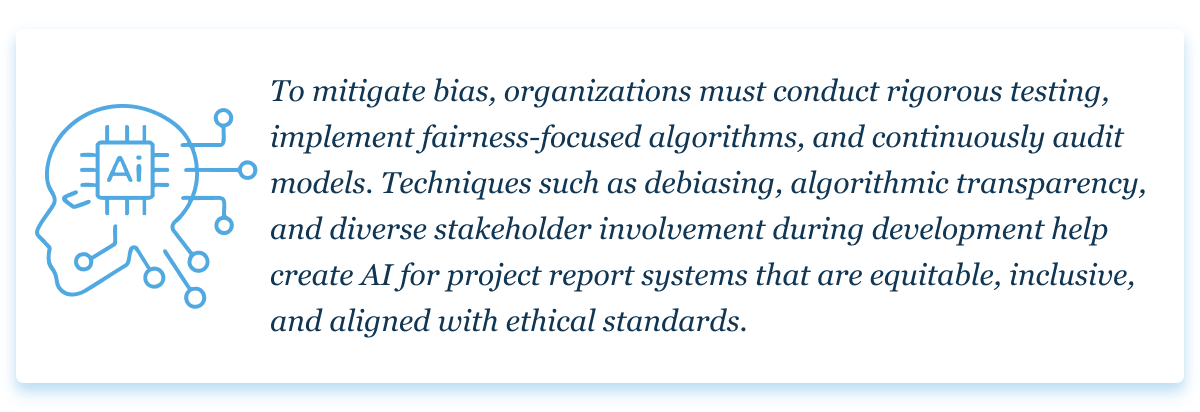Have you been looking for ways to optimize your workflow and ensure precision at every step? To achieve these goals and maintain a competitive edge, businesses increasingly turn to AI for reporting, leveraging its ability to process vast amounts of data quickly and accurately.
Traditional tools often struggle to handle the sheer volume of available information, pinpointing the need for modern and innovative approaches. Evidently, by enhancing decision-making, you will become able to predict trends, identify opportunities, and mitigate risks, ensuring you stay ahead in a rapidly evolving landscape. Therefore, in order to go further into the subject, this article will examine fundamental elements, important technologies, practical uses, and the advantages you obtain across different sectors.

Source: Unsplash
What is Generative AI for reporting all about?
In essence, what this means is that computers and other machines may learn from human experiences to understand and react to language, decisions, and issues in a way that is similar to how the person’s mind works.
This is an innovative new approach that harnesses the capacity to transform raw data into actionable insights. Throughout the globe, this state-of-the-art combo has revolutionized numerous sectors. Moreover, in 2023, the industry was worth around $200 billion, and by 2030, experts predict it will have exploded to over $1.8 trillion.
Using complex algorithms and computer models to look for trends, patterns, and important insights that help with better strategic-making is a basic part of it. Additionally, it has the potential to improve general performance, optimize procedures, and forecast results.
Key approaches to Generative AI for reporting
Tools have evolved to tackle the complexities of analysis, offering specialized methods that extract insights beyond the capabilities of traditional approaches. Like a well-equipped toolkit, different AI sales solutions cater to specific tasks and industries, enabling you to make weighted choices, automate processes, and uncover valuable patterns.
Now, we will examine the different features that contribute to delivering an exceptional experience.
Natural language processing (NLP)
It focuses on understanding, generating, and interacting with human language. This approach powers chatbots that simulate human conversations for customer support, language translation tools that break down communication barriers, and sentiment analysis that helps businesses assess consumer opinions on products and services.

Source: Unsplash
Machine learning (ML)
ML enables systems to learn from patterns, make predictions, and automate decision-making. It plays a crucial role in recommendation engines that personalize content and product suggestions, fraud detection systems that identify suspicious activities in finance, and predictive maintenance solutions that optimize equipment upkeep by forecasting potential failures.
Neural networks
Neural networks, inspired by the human brain, excel at recognizing complex patterns and relationships. They are fundamental to image recognition, allowing computers to detect objects, faces, and scenes in images, as well as speech recognition, which enables voice assistants to interpret and respond to spoken commands with increasing accuracy.
Deep learning
Deep learning, a subset of neural networks, is designed to process large-scale, intricate structures. It is particularly valuable in fields like autonomous driving, where vehicles analyze real-time sensor data to navigate safely. In medical diagnostics, AI examines X-rays and MRI scans to detect abnormalities, while in financial forecasting, deep learning models process vast amounts of market data to predict trends and guide investment strategies.
Applications of artificial intelligence in financial reporting and other industries
AI for generating reports is transforming industries by enhancing productivity, providing a clear strategic picture, and unlocking valuable insights. Its impact is driving innovation and reshaping business processes across sectors, from healthcare to energy. Here’s a look at the key industries where you can successfully apply the latest advancements.
Healthcare
It is a game-changer in the medical field, enabling early disease detection and customized treatment plans. Analyzing patient histories and diagnostic images and implementing EHR along with predictive analytics helps doctors identify health risks before they become critical. This leads to timely interventions, reducing healthcare costs and improving patient outcomes. Additionally, insights support personalized treatment by assessing genetic makeup and past responses to therapies, ensuring more precise and effective care.

Source: Unsplash
Marketing
In marketing, AI for writing reports powers personalized consumer experiences. Recommendation systems analyze user behavior, purchase history, and preferences to offer tailored product and service suggestions, boosting engagement, sales, and brand loyalty. Businesses also use technologies to optimize audience segmentation, launch highly targeted campaigns, and increase conversion rates, maximizing return on investment.
Finance
The financial sector relies on it for market analysis and risk mitigation. Trading algorithms process massive amounts of financial records to identify patterns, anomalies, and opportunities in real time.

Transportation
AI for creating reports enhances transportation safety and operational efficiency. In aviation, systems analyze real-time sensors to predict mechanical failures, allowing for proactive maintenance and preventing costly malfunctions.
In urban transportation, traffic management systems process information from sensors and cameras to optimize traffic flow, reduce congestion, and shorten travel times, creating a more efficient transportation network.
Manufacturing
This is transforming manufacturing by improving production efficiency and quality assurance. Predictive maintenance powered analyzes sensors to anticipate equipment failures, minimizing downtime and preventing production delays.
Also strengthens quality control by identifying defects in manufacturing processes, ensuring only high-quality products reach the market, enhancing customer satisfaction, and enhancing brand reputation. To learn more about predictive maintenance and failure control, please watch this video:
Energy
In the energy sector, it plays a critical role in resource optimization. Smart grids monitor energy consumption patterns and adjust supply dynamically, reducing waste and improving distribution efficiency.
Predictive maintenance helps detect potential failures in power plants and transmission networks before they occur, ensuring uninterrupted service and preventing costly disruptions.

Source: Unsplash
Why AI is irreplaceable for financial reporting
Who wouldn’t want a smarter, faster, and more precise way to extract insights? Artificial intelligence capabilities go beyond traditional methods, enabling businesses to uncover hidden opportunities, boost efficiency, and elevate customer experiences.
It is rapidly evolving and has the potential to bring about several advantages, including cleaner and safer transportation, more effective production, and less expensive and more long-term energy. In 2024, the technologies were utilized by 11.21% of small, 20.97% of medium, and 41.17% of large businesses.
In this section, we explore the key benefits and how they are revolutionizing the way you create business strategy for your company.
-
Expanded processing capabilities
In today’s digital world, the sheer volume of data can overwhelm traditional methods. Artificial intelligence financial reporting, however, thrives in this environment, effortlessly sifting through massive datasets to extract valuable insights. This enables you to discover patterns, optimize operations, and make more informed strategic choices.
-
Faster insights and real-time outcomes
With machine learning algorithms and automated processing, AI consultants deliver insights almost instantly. Whether tracking customer behavior, monitoring market trends, or detecting operational inefficiencies, it empowers businesses to act swiftly and seize opportunities in real time. To learn more how to get insights into customers’ behavior, watch this video:
-
Unmatched accuracy & reliability
It significantly reduces human error by relying on algorithms that process objectively and consistently. Business intelligence in finance allows for highly accurate insights, improving confidence in your organizational choices and minimizing costly mistakes.
-
Accurate decision-making
AI for reporting and analytics excels at identifying meaningful trends and correlations within large datasets. By leveraging these insights, you can make well-informed decisions that align with consumer preferences, market demands, and competitive shifts.

Source: Unsplash
-
Increased productivity & efficiency
By automating tedious processing tasks, AI-automated decision-making frees up skilled professionals to focus on high-value initiatives. This boosts overall productivity, allowing organizations to allocate resources more effectively and drive innovation.
-
Enhanced customer experiences
Understanding customer behavior is crucial for success, and AI for report generation provides deep insights into consumer preferences, purchasing habits, and engagement patterns. You can use this to personalize interactions, improve customer satisfaction, and foster brand loyalty.
-
Proactive risk management
The AI app for report writing helps you identify potential risks before they escalate, whether related to cybersecurity threats, market disruptions, or operational vulnerabilities. This proactive approach strengthens resilience and improves overall risk mitigation strategies.
-
Seamless process automation
You can automate complex workflows, streamlining end-to-end processes and ensuring that AI in accounting models can be deployed at scale. This reduces manual intervention, enhances consistency, and optimizes pipelines.
Challenges and considerations in AI for reports to keep in mind
While there are many advantages to using AI for annual reports, there are also certain obstacles that businesses must carefully overcome. In order to make the most of the opportunity while limiting the danger, it is essential to resolve these concerns.
In order to make the process as smooth as possible for you, we’ll go over a few of the things that need to be considered.
Privacy and security
AI for creating project reports relies heavily on data, making privacy and security paramount concerns. It is necessary to comply with stringent protection regulations such as the General Data Protection Regulation (GDPR) and the California Consumer Privacy Act (CCPA) to safeguard sensitive information and maintain consumer trust.

Source: Unsplash
Implementing robust governance frameworks, encryption protocols, and access controls is essential to prevent breaches and unauthorized access. Additionally, maintaining transparency in statistics collection and usage practices—through clear communication and obtaining explicit consent from users—ensures compliance and fosters trust among consumers and stakeholders.
Bias and fairness
Systems can unintentionally reinforce biases present in training, leading to unfair or discriminatory outcomes. This is particularly concerning in industries like finance, healthcare, and employment, where biased decisions can have serious legal, ethical, and social consequences.

Seamless integration with existing systems
Integrating AI tools for report generation into legacy infrastructure can be challenging due to silos, outdated systems, and incompatible formats. Poor integration can lead to inefficiencies, inconsistencies, and operational disruptions.
A strategic approach to integration is essential, including careful planning, structured mapping, and the development of robust APIs and interoperable interfaces. Additionally, providing employees with comprehensive training and ongoing support ensures a smooth transition, enabling them to use AI for report-writing tools effectively.
Bottom line
Artificial intelligence financial reporting has become an effective resource for analysis and decision-making. It improves comprehension of operations, consumers, and market dynamics by the use of natural language processing, deep learning algorithms, and robots to produce actionable insights.
It is driving innovation and transforming industries with its pattern-finding and data-processing capabilities. Changing the way your business functions, expands, and engages with customers by deducing patterns, forecasting results, and directing strategic decisions provides you a head start over competitors. In today’s highly rival market, utilizing this technology will give you a leg up and allow you to reach new heights.
FAQ
-
It directly depends on your very specific needs. For example, tools like ChatGPT and Claude can assist with structuring content, summarizing research, and refining language. Grammarly is great for grammar and style, while Zotero or EndNote helps with citations. If you need analysis, IBM Watson or GPT-4 with code capabilities can process complex datasets. However, it should be used ethically—to assist rather than replace your critical thinking and research.
-
Yes, journalists can use it to enhance their work. Certain tools can help with research, fact-checking, content summarization, and automated transcription of interviews.
Platforms like ChatGPT or Jasper assist with drafting articles, while tools like Google’s Fact Check Explorer verify sources. AI tools for report generation also aid in journalism, creating insights from large datasets. However, ethical considerations and human oversight are essential to ensure accuracy and credibility.
-
It helps by automating the collection, identifying compliance risks, and generating insights. Platforms like SASB’s tools, Microsoft Sustainability Cloud, or IBM’s Envizi analyze large datasets to track emissions, monitor supply chain ethics, and assess regulatory compliance. Natural language processing (NLP) helps summarize reports while predicting sustainability trends, improving decision-making and transparency in ESG initiatives.



